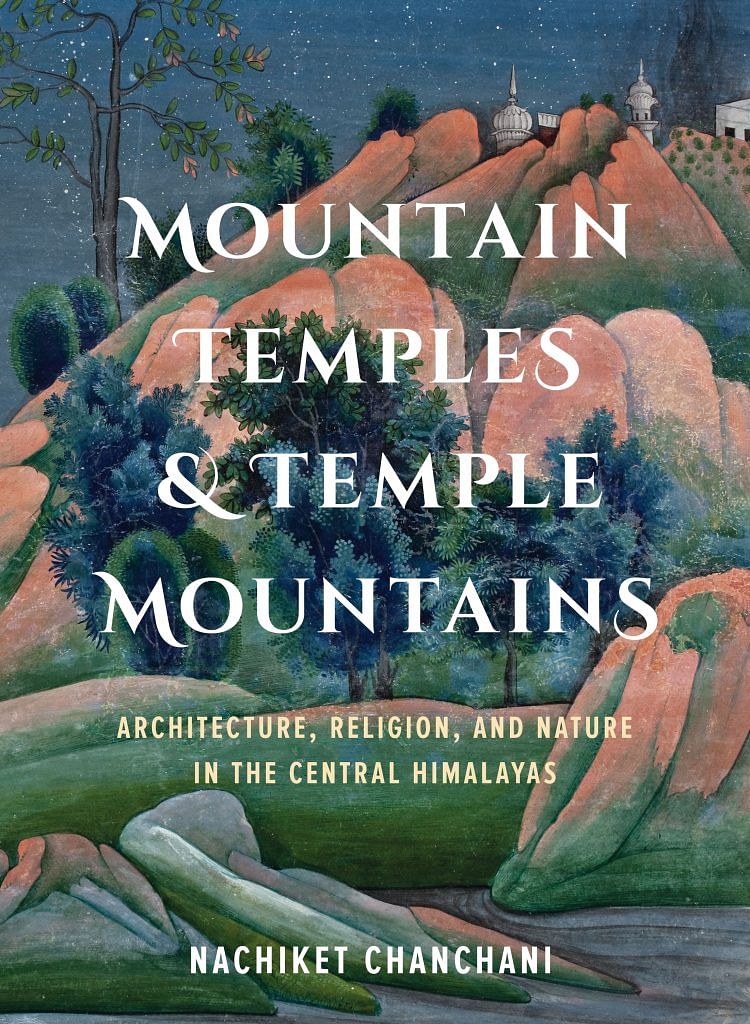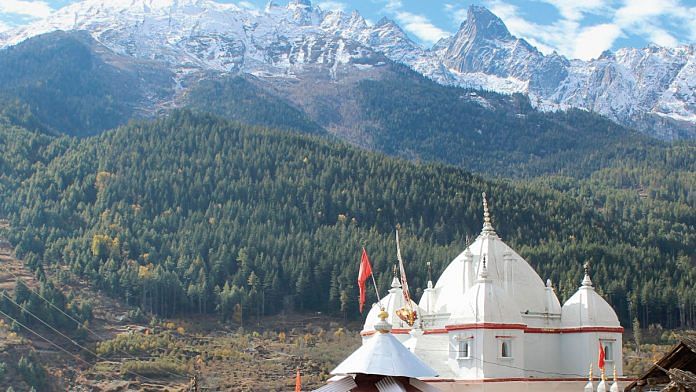The Central Himalayas encompass an area roughly corresponding in size to the combined territory of Austria and Switzerland. In their geologic and ecological constitution, they are more variegated than either of these two mountainous countries. In the north, the range extends from the windswept Tibetan Plateau in China. Southward, the Central Himalayas extend to the dense Terai forests and tiger-infested swamplands that fringe the Gangetic (or northern) Indian plain. The Tons River sets a clear western boundary. The eastern boundary is more amorphous. It extends at least as far as the Kali River and by some reckonings up to the Karnali River. The Kali commences in India and serves today as the political border between India and Nepal, while the Karnali begins on the Tibetan Plateau and flows through western Nepal to join the Ganga in India.
Geographically and culturally, the Central Himalayas stand apart from other segments of the sprawling mountain range. While precipitation in the Western Himalayas flows into rivers that reach the Arabian Sea, the hail, rain, and snow that fall in the Central Himalayas eventually flow into the Ganga and through it into the Bay of Bengal. Magnificent in scale, the Central Himalayas consist of a series of ridges, each perceptibly higher than the preceding one. Even the front (southern) ridge rises to an altitude of nearly 2,750 meters above sea level (msl). Farther to the north, Nandā Devī, the highest peak in India, is part of the ridge that adjoins the Tibetan Plateau. It soars to an altitude of 7816 msl. Several other peaks in this final ridge rise to altitudes of more than 7,315 msl.
Mighty rivers originate at the mouths of immense glaciers coiled in these highest ranges. From west to east, the most famed rivers, with the richest cultural associations, are the Yamuna, Bhagirathi, Mandakini, Alaknanda, and Kali. The Mandakini merges with the turquoise waters of the Alaknanda at Rudraprayag, and the Alaknanda converges with the bottle-green waters of the Bhagirathi 80 kilometers downstream to form the Ganga proper. From Devaprayag onward, the Ganga flows to the Sundarbans delta at the rim of the Bay of Bengal, nearly 1,700 kilometers away. The sacred landscape of the Central Himalayas is watered by these glacial rivers and by countless other lesser rivers including the Aglar, Ramganga, and Kosi that begin from springs in the region’s middle ridges.
Also read: Drugs, media frenzy and spirituality: When the Beatles visited Rishikesh
In contrast to the adjacent northern plains, which are today among the world’s most densely populated regions, the Central Himalayas are sparsely populated. Historically, as today, climate and topography have affected the size and distribution of the human population. Harsh temperatures and meager topsoil impede cultivation above 3,200 meters and discourage year-round habitation above this altitude. Lower altitudes are relatively densely forested, and the climate is milder. But in this zone, the slopes are often too steep to allow extensive transformation into arable terraced fields.
Therefore, the largest and historically most significant settlements are found in fertile river valleys. Smaller villages tend to be perched halfway up the mountainsides, ensconced between forests and fields, resources that provide them with sustenance. Other hamlets tend to be strung out along knolls; these places are sunny, relatively level, and offer splendid vistas. Mountaintops in the middle ridges of the Central Himalayas are carpeted with meadows full of herbs and wildflowers. However, as water sources at summits tend to be scarce, they seldom attract permanent settlements. Most are occupied in the summer months by seminomadic pastoralists and more sedentary agrarian communities.
The challenging topography has played its part in thwarting modern attempts to reconstruct the region’s history. Even today, hundreds of settlements remain unconnected by motor roads. They also have little or no electricity, phone connectivity, piped water, or other basic amenities. Not surprisingly, in contrast to the sacred centers and sites of archaeological and cultural significance in adjoining realms—including the erstwhile kingdoms of Kashmir and Chamba, the Tibetan principalities of Guge and Purang, and the polities of the Kathmandu Valley—those located in the Central Himalayas, scarcely mapped, have found virtually no place in art historical surveys or special exhibitions produced in recent decades. These sacred centers remain understudied. In 1990, social anthropologist Dinesh Kumar wrote that “no significant work” had been undertaken on the region’s Hindu pilgrimage centers. In 2015, cultural historian Alex McKay reflected that this has remained “largely true.”
Still, to suggest that the region remains a terra incognita for archaeologists and students of religion would be incorrect. European missionaries began exploring the region in the seventeenth century and occasionally wrote of the fabulous wealth of its temples and the angelic quality of its sculptures. From the late nineteenth century onward, certain professional archaeologists overcame the difficulties and reached Central Himalayan sites of historical and cultural significance. The most resolute among them were Harold Hargreaves, Daya Ram Sahni, Hermann Goetz, and Kanti Prasad Nauti-yal. At these sites they were confronted with a rich if also eclectic corpus of material remains from centuries past: boulders bearing inscriptions, fire altars, temples, water-resource structures, commemorative monuments, caravanserais, coin hoards, wooden halls, polished stone steles, and freestanding sculptures of gilt and copper alloy. As they hurriedly surveyed these materials, they discovered that not one of them bore a precise date. Even the fundamental task of formulating a chronology of landmark buildings and sculptures thus presented a challenge. Not surprisingly, the dates that these pioneering archaeologists assigned to individual monuments and sculptures have sometimes varied by five hundred years or more.
Also read: How Hinduism incorporated Buddha and then distanced the religion
In assigning dates, these archaeologists often relied on the viewpoints of government officers posted in the region as well as influential reconstructions of the region’s history authored by a heterogeneous group of nonprofessional historians: British as well as Indian artists, army captains, lawyers, missionaries, playwrights, surveyors, and timber harvesters. As the historian Antje Linkenbach has noted, shifting ideological concerns, rather than a thorough examination of the material and textual evidence, molded their perceptions. Consider, for example, the case of Ram Bahadur, a hill man who retired from service as a surgeon in the British Army. In his book Garhwal: Ancient and Modern, he plainly states that his account was intended to demonstrate how a “land of darkness…which had impregnable barriers,…jungles infested with thieves and furious wild beasts,” and whose people had been “oppressed by previous governments,” was finally enjoying the idyllic “Ram Raj of venerable antiquity” under the peaceful reign of the British King Emperor. Some nationalists responded to obsequious narratives of this kind by authoring books with alternative accounts.
However, their ideological commitment to showing, on the one hand, a long-standing tradition of autonomy in this frontier region and, on the other hand, its unquestioning loyalty to other polities in the Indian “heartland” frequently led them to aggrandize obscure phenomena. For example, despite a dearth of epigraphic evidence, Badri Datta Pande claimed that the short-lived Katyuri dynasty ruled over territories consisting of British Garhwal, British Kumaon, and much of Tehri State from 2500 BCE to 700 CE. In his tome, Pande also proposed that the obscure Chand dynasty gloriously reigned over the region from 700 to 1790 CE and built and maintained hundreds of stone temples, a position that has been recycled and embellished by local scholars.
The need to craft a more credible working chronology of key monuments and to develop a more plausible understanding of the circumstances under which they were erected is scarcely the only challenge that confronts a scholar today. Mounds await excavation. Edifices await extrication from landslides, from hydropower reservoirs in which they lie half submerged, and even from modern habitations that have incorporated them. Many exquisitely sculpted structures, unprotected from the elements, await discovery and study. Some lie in ruins, and elements of others are strewn in millet fields, snuggled in śāla forests, or affixed to the retaining walls of barns.
Even those monuments that have received state protection and have been conserved by government archaeologists pose problems for a student interested in the region’s past, for no records have been kept of their condition before conservation. The vast majority of icons, in stone and metal, have been removed from their original find-spots. A few dozen are on display in museums in South Asia, North America, and Western Europe; hundreds are locked in older buildings that have been arbitrarily converted into safe houses. Owing to the dearth of information about their find-spots and original contexts, the task of gauging the ways in which the icons were approached, perceived, and venerated becomes challenging. South Asia is one of the greatest repositories of premodern inscriptions. These are a crucial source for writing historical narratives. However, as epigraphists working in the region know well, the inscriptions are not evenly distributed. In general, South India has yielded far more inscriptions than North India.
In 2005, government epigraphists recorded that about thirty thousand precolonial inscriptions have been found in the southern state of Tamil Nadu alone. The number has certainly risen since then. In sharp contrast, fewer than two dozen inscriptions datable to the period extending from the third century BCE to the twelfth century CE—the period that is this book’s primary temporal focus—have been found in the Central Himalayas. Even the adjacent Kashmir and Kathmandu valleys have yielded many more. Leaving aside for the moment the reasons for the extreme paucity of inscriptions in the region, other difficulties that impede their careful study may be noted. Many inscriptions are in fragmentary condition. Several have been moved more than once, and records of their exact location at their moment of discovery by modern scholars generally have not been kept. Two are known to be period forgeries. Some inscriptions have been lost since their discovery, and a scholar who wishes to study them today must rely entirely on published transcriptions, translations, and summaries.
Moreover, while these inscriptions often mention the names of ceremonial capitals, market towns, villages, rivers, forests, pastures, and fields, it has proved impossible to determine the precise locations of most of these settlements and properties, because their names do not appear in other surviving records. Lastly, local memories surrounding the rulers and officers mentioned in the inscriptions and the activities historically undertaken at these monuments have long since faded.
 This excerpt has been published with permission from Niyogi Books.
This excerpt has been published with permission from Niyogi Books.



